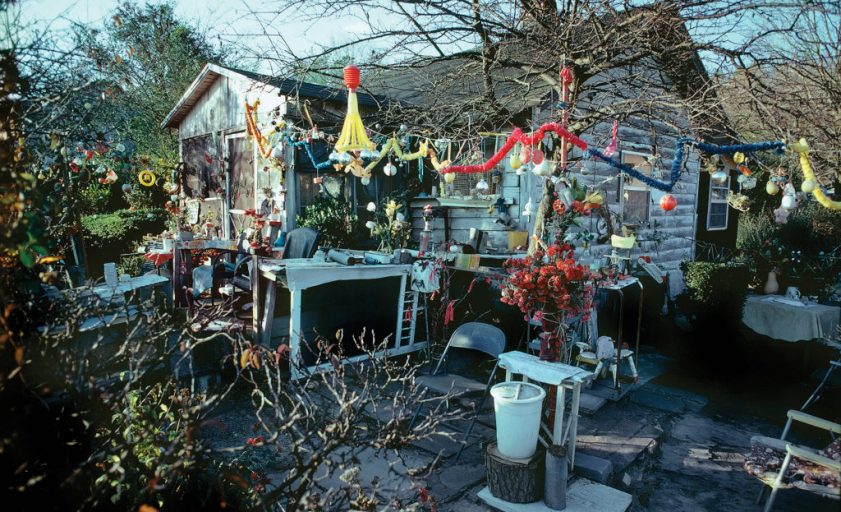The Constant Curator: The Important Work of Nellie Mae Rowe
by Katherine Gibson
The exhibition REALLY FREE: THE RADICAL ART OF NELLIE MAE ROWE was on view at the High Museum of Art, in Atlanta, Georgia, from September 3, 2021 – January 9, 2022, and was organized by Katherine Jentleson, the Merrie and Dan Boone Curator of Folk and Self-Taught Art.
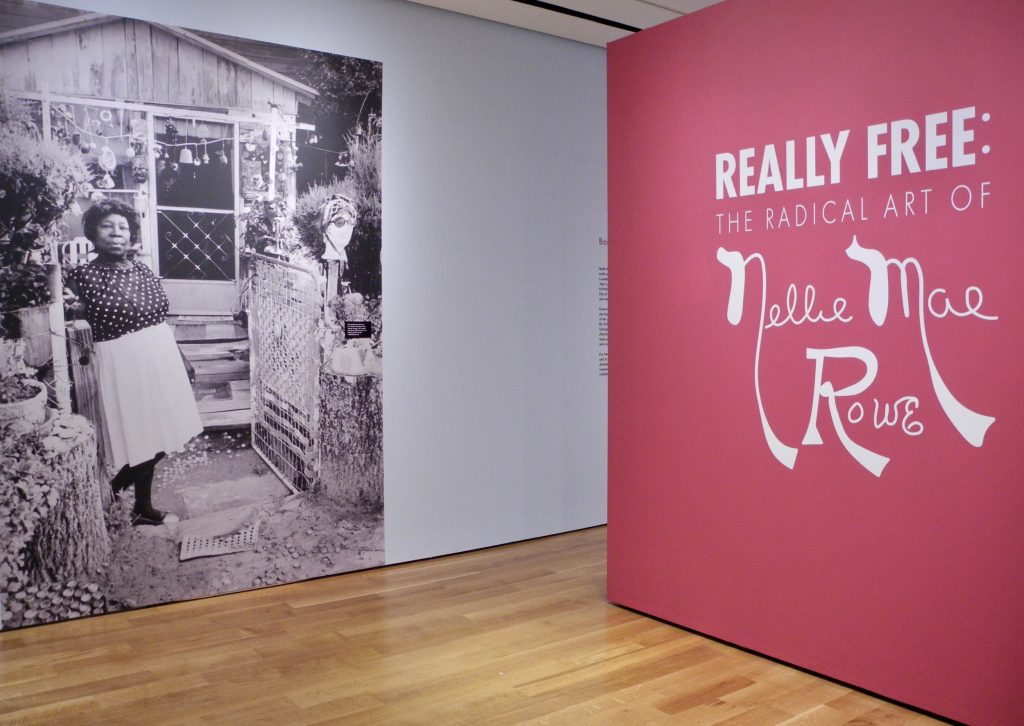
Nellie Mae Rowe greeted me at the gate to her home – at least her likeness did, in the blown-up, life-sized, black and white image of her at the entrance to what she called her Playhouse (referring to her house and yard area). The giant fuchsia wall to the right presented Nellie’s artistic signature as an essential part of the exhibit title, “Really Free: The Radical Art of Nellie Mae Rowe.”
It was the day after Christmas. My sister Jane and I, along with our niece Katie, took in the Nellie Mae Rowe (American, 1900-1982) exhibit at the High Museum of Art in Atlanta. Jane and Katie walked through the show, reading the text for each piece and following the gallery sequence. I’m envious of people who can do that. I don’t seem to be able to go in order, and as a result, I often miss important connections. What I’m always most interested in, is the overall feel of a show, the environment created, the mood and the flow of how someone may experience it. I amble around the space, in no organized way, absorbing visual impressions and relationships.
After a few times around in various directions, I found I wanted the exhibit to feel more connected. The spacing between pieces and groupings was generous, perhaps more than needed. Given that Nellie’s home was chock full of colorful things and objects inside and out – the galleries were spare in comparison, and somewhat static. I felt like the layout could have infused more of the vibrant energy, conviction and general playfulness that Nellie lived by.
That said though, how do you infuse a stagnant exhibit with Nellie’s kind of joyful flow? How do you translate her world into a world others can experience – and, do you need to?
In ruminating over the exhibit and these questions, I can understand what a challenge it was to come up with the best way to show Nellie Mae Rowe’s work. The environment she created throughout her home and property had the same traits as the images she created: layered and overlapping; full of rich color from end to end; animals, objects, plants, sculptures all existing together. One was not separate from the other. I don’t think I got this until later, when I was scrolling through my images, still feeling like something was missing, and then it dawned on me that it was near impossible to convey Nellie’s world without her masterpiece Playhouse.

Photo ©Lucinda Bunnen, collection of the artist, courtesy of the High Museum of Art, Atlanta.
That’s where an unbelievable scale model of Nellie’s Playhouse comes in. Unique to this exhibit, Opendox, a New York documentary-making firm, created two scale models of the Playhouse – the first model was of the entire property presented on a large, flat, table-like surface akin to something a model train environment might sit on. The second model was larger, and was assembled in a corner area near the end of the exhibit, with created interior rooms the size of a child’s playroom.
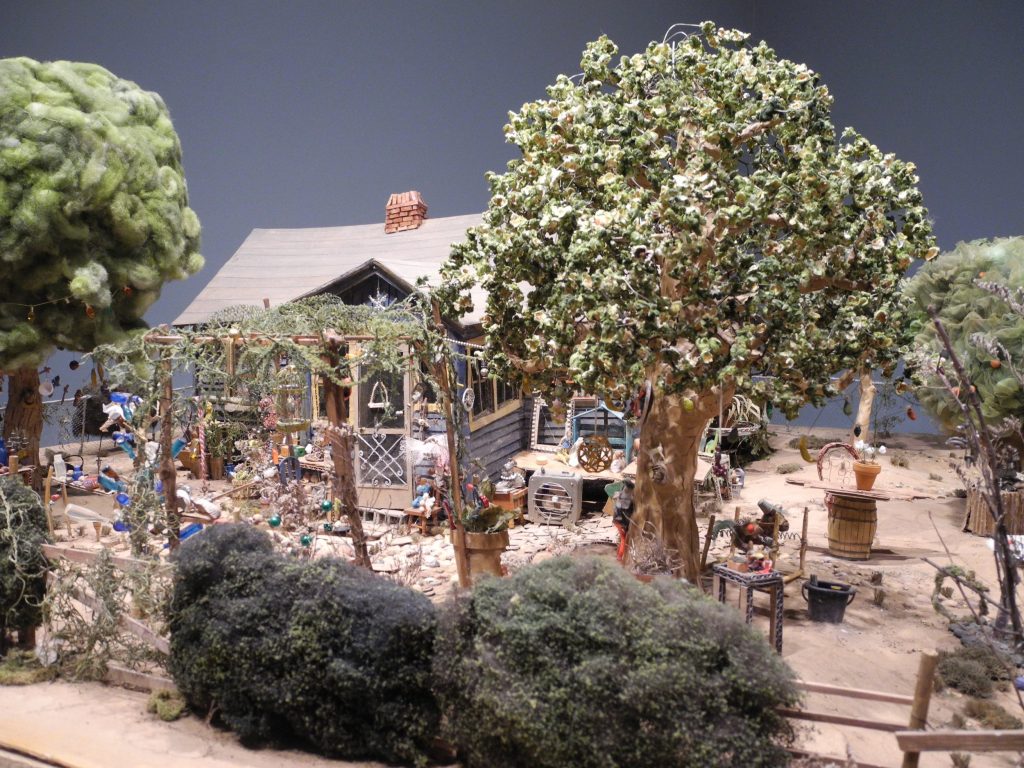

The miniature model of the entire property drew me in and completely blew my mind due to the amazing detail, down to the tiniest possible replica of the many objects scattered throughout Nellie’s environment. Same with the child-sized model of interior rooms of the Playhouse, created to use in filming the documentary about Nellie and her life. “This World is Not My Own” will be available later this year and will be fascinating to watch – not only to learn more about Nellie Mae Rowe and her unapologetic way of living her creative life, but also to see these astounding, meticulously created sets in context. (https://thisworldisnotmyown.com/)
My sister really loved the short film about the making of the documentary that was part of the exhibit, next to the scale house created for the filming. Those components of the exhibit, she said, helped her get a palpable sense of Nellie’s world and gave context for how Nellie lived. Jane appreciated the tactile model combined with the sound in the film because it made the experience of Nellie’s garden come alive for her.
Strangers Welcomed
Nellie’s home was in a small town west of Atlanta.
“When passersby in sleepy Vinings saw Nellie Mae Rowe’s decorated yard packed with handmade dolls and chewing gum sculptures and beads and wigs hanging from trees, they didn’t know what to make of it,” wrote Bo Emerson in an article for The Atlanta-Journal-Constitution (May 18, 2021). “Some gawked. Some thought she was a “hoodoo” woman or a fortune teller. Some pitched bottles through her windows and broke her flower pots. She met all responses with poise. Those who threw missiles, she invited in to see her yard and her ‘playhouse.’ …Her guestbook was signed by more than 800 people who had toured her house and gardens just from May 1973 to March 1975.”
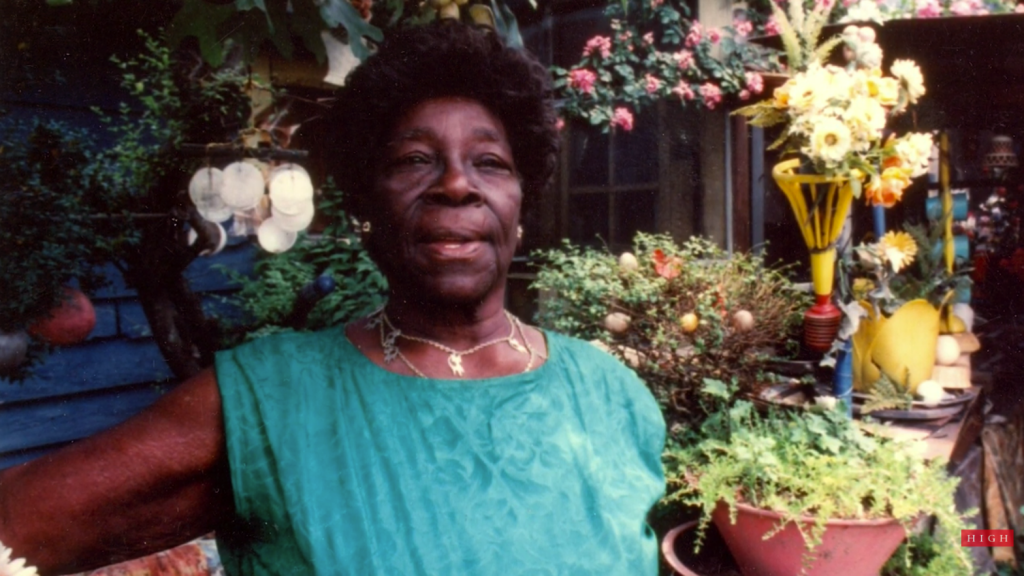
Chewing Gum Sculpture
The idea of creating figures out of chewing gum initially repulsed me but in the context of Nellie’s clever resourcefulness, I found it humorous, especially when I saw the figure featured in the exhibit. “He” was an animal – possibly a cat – with a hair mustache and a large plastic flower on his backside (see image). As I took him in, I noticed how well he was formed and sculpted; a concentrated effort yet it still had the playful lightness Nellie brought to her creations.
“I chewed a lot of chewing gum because the doctor said chewing would help the jumping in my head. People began bringing me packages of chewing gum. And I said, now as much chewing gum as I chew, I’m going to make something. So I saved my chewing gum and when I saved a big ball, I started making things. I used to have chewing gum cats and dogs all up and down my fence. Now, I chew gum just to make things.” (https://www.soulsgrowndeep.org/artist/nellie- mae-rowe)
You can imagine the delight she must have felt in bringing this mustached character to life, adding white decorative beads and a smaller flower on his head casually cocked to one side, like a British fascinator.
He was a feature in the exhibition, singled out, and presented on a large pedestal, under a tall clear bonnet – all adding to his importance, which made him even more entertaining to me.
-
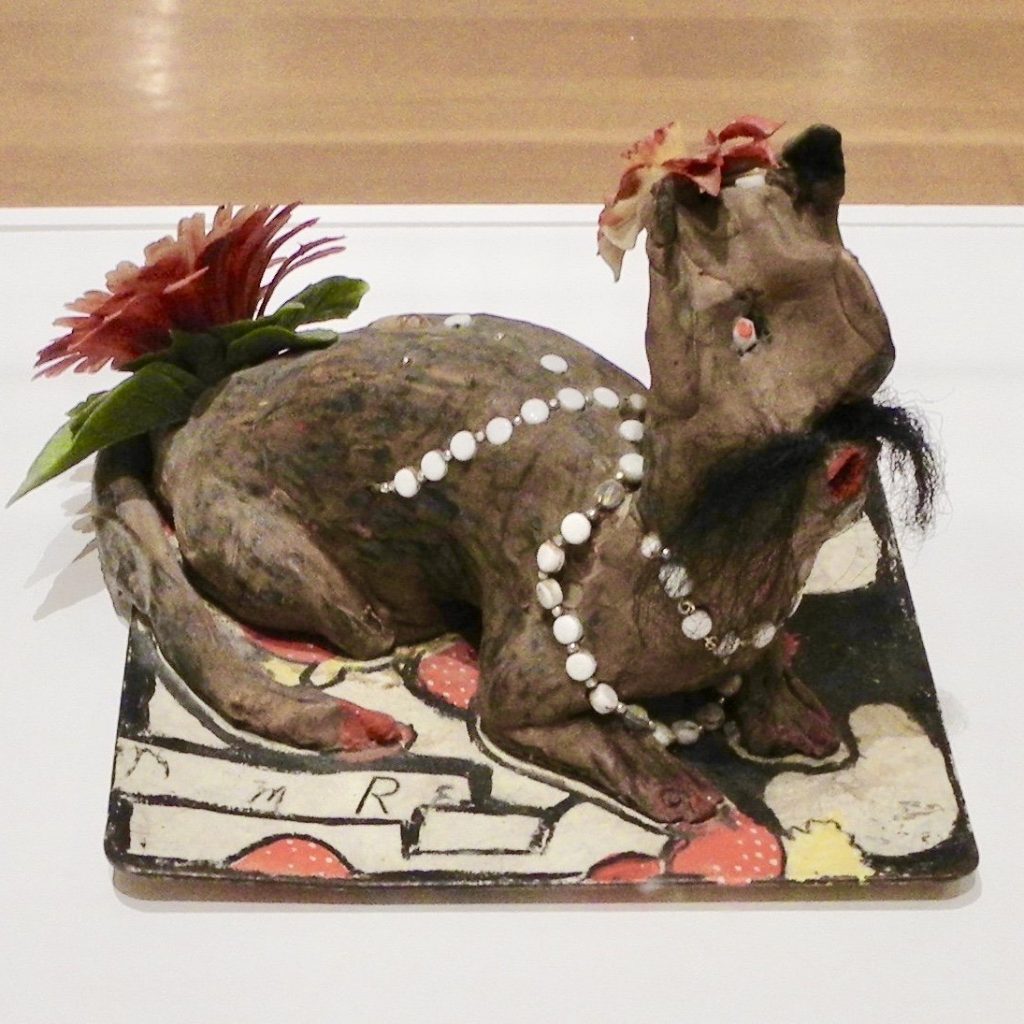
Untitled (Chewing Gum Sculpture), before 1978, front. High Museum of Art. -
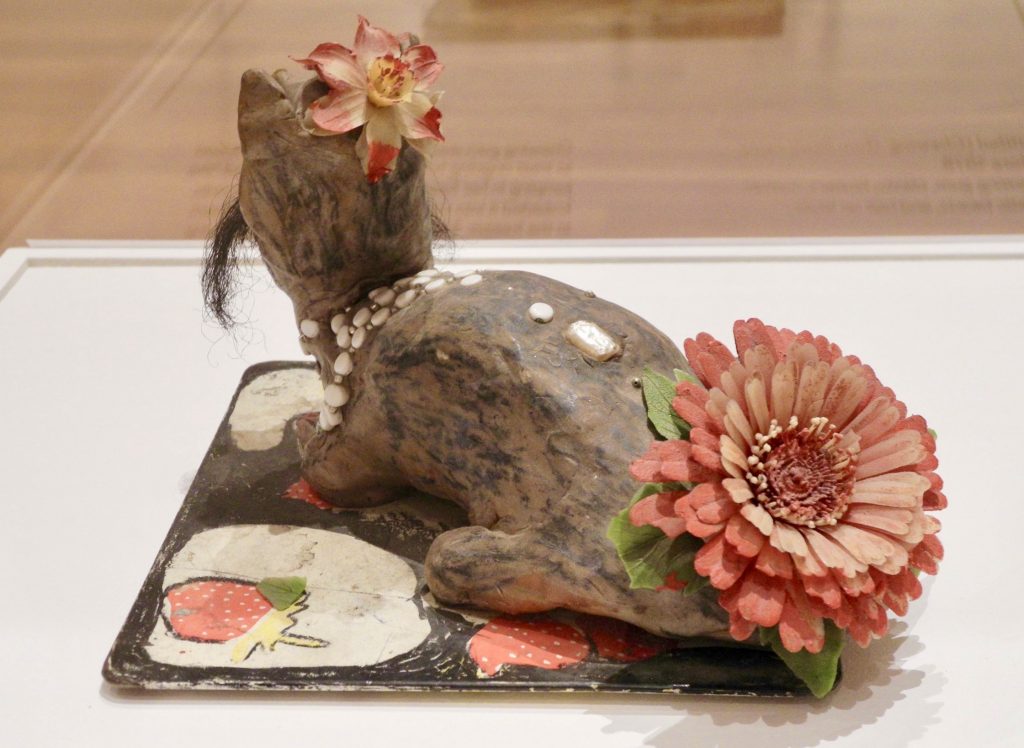
Untitled (Chewing Gum Sculpture), before 1978, back. High Museum of Art.
Judith & Nellie Mae
Nellie met gallerist Judith Alexander when she was in her late 70s. They knew each other only a few years, yet it seems like – from all accounts – they deeply trusted each other and formed a unique and solid friendship. On the Judith Alexander Foundation website is a section about Nellie with a description of their influences on each other:
“Of all the artists whose lives Judith Alexander touched, none was as strong an influence on her as Nellie Mae Rowe. It’s safe to surmise that Judith’s influence on Nellie was equally powerful. Theirs was a relationship that took the notion of synergy way beyond its boundaries.
“Judith saw to it that Nellie Mae Rowe’s legacy would endure with her major gift of works to the High Museum of Art in Atlanta. Judith also established The Nellie Mae Rowe Gallery at the museum, an area exclusively dedicated to a rotating display of the work.” (www.judithalexander.org/brief-biography)
One of the pieces that resonated with me was a detailed, colored drawing of two, almost identical houses, side by side. The form of a tree is drawn rising up from the center where the houses are joined. On the top of each roof is a figure – one appears to be the figure most often associated with Judith (lighter skin tone and more formally dressed) and the other most likely representing Nellie. As I study the drawing, it clearly conveys to me that each figure has their own domain yet their intersection is strong, beautiful and growing.
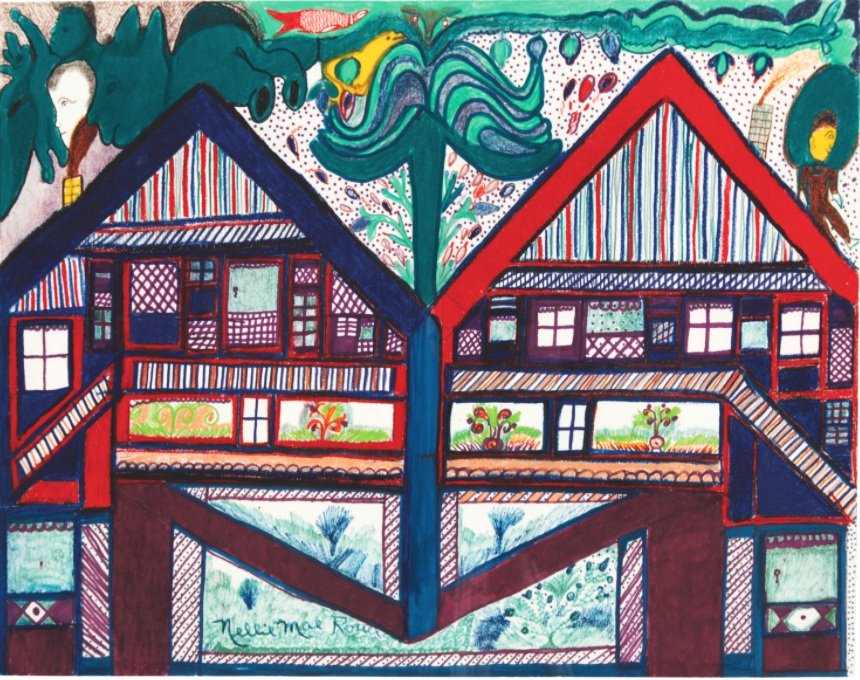
The exhibition wall text reads: “These conjoined houses signify how the destinies of Rowe and her gallerist Judith Alexander were mutually dependent. Alexander had been showing contemporary art for decades, but her close relationship with Rowe led her to become one of the South’s only gallerists dedicated to self-taught artists.”
Sense of Place
To look at pictures of the inside and outside of Nellie’s home, you may think things were strewn willy-nilly but Judith Alexander made a point of saying (in some of the referenced videos) that Nellie used the word “placed” when talking about arranging pieces in her home, and further explained that she purposely put things in a certain location because that’s how she wanted to see them. I think of Nellie as a constant curator, incorporating pieces she made or found, with pieces and things people gave her.
Nellie shares some of the things her visitors would bring her in this interview transcript available on the Souls Grown Deep Foundation site:
“The yard was decorated pretty. Because of the talent God gave me, many people started visiting and taking pictures. What is exciting and surprising and makes me feel good is to think about the people I would never have seen if I had not been doing things that were interesting to them. Folks brought me all kinds of things: dolls, stuffed animals, beads, bottles, and sometimes strangers would leave things at my gate. I would place them in my yard and some I would hang indoors against the walls. Everything else, other than what people gave me, I picked up. I like it when things keep on changing; keeps me busy.”
Rolling Tree Mule
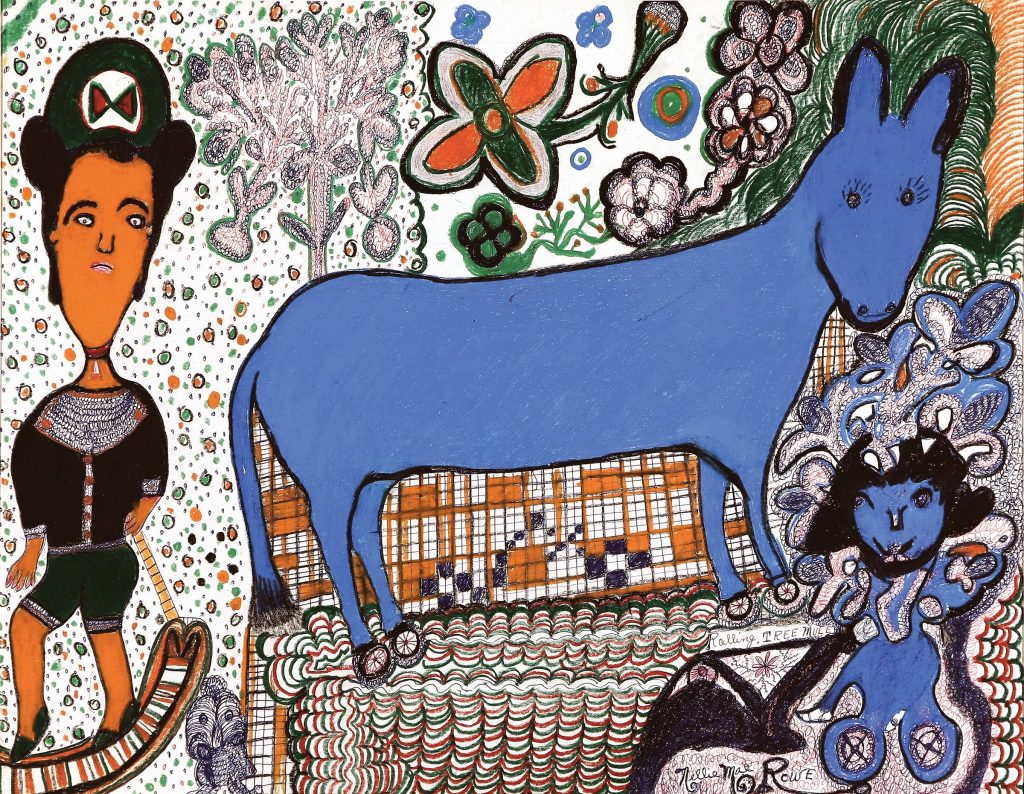
Museum of Fine Arts, St. Petersburg, Florida.
Two works by Nellie Mae Rowe are included in the Museum of Fine Arts (MFA) St. Petersburg, Florida, collection. One is seen above. This image of Rolling Tree Mule is also included on their website, highlighting pieces from the permanent collection, and offers this brief summery of Rowe’s life:
Rowe faced racism and discrimination, was widowed twice, and worked as a domestic for roughly thirty years. Born in Fayetteville, Georgia, she spent most of her life in Vinings, outside of Atlanta. Her parents were farmers and also made handicrafts: her father, born into slavery in 1851, smithed and made baskets; her mother made quilts. As a girl, Rowe made dolls out of rags and figures from chewing gum. In 1948, after the death of her second husband, she began making art, “something out of nothing.” She saw her artistic life as a second childhood, terming her home “Nellie’s Playhouse.”
Play
Rowe was proud and happy about what she was creating. When creativity comes purely and directly through a person, it doesn’t need explanation, permission or approval. The result is the rawest and most authentic kind of expression.
In Nellie Mae Rowe 1 video (YouTube, 1976), Nellie is moving around her garden area, sweeping, planting, and fussing with various things as she meanders. Her voice can be heard over the footage, explaining “I do too many things, start sewing, next thing, I’m outdoors in my hole (garden), then uh, put that down, and then go to drawing a little, that’s just how it go… I never finish nothing at once. I just enjoy playing like that. I’m like a child. I wanna play in my Playhouse.”
Closing
At the start of this writing, I was seeking to share impressions of the High Museum’s exhibition of Nellie Mae Rowe’s work. While I have shared some impressions, I found Nellie herself to be more compelling to think about, and to write about, so I’ve taken liberties to include some of those impressions too.
There is so much to admire about her – especially the way she crafted her life in just the way she wanted to live it. And in doing so, the barriers that would have normally limited her success – being a woman, an artist, black, and older – she instead, moved right through them, inviting anyone and everyone into her home to experience her Playhouse. Imagine this kind of generous invitation now, much less in the 70s.
Nellie Mae Rowe was a constant curator living in her greatest work of art. The ever-evolving Playhouse environment was a major source of energy and motivation where she was able to express her thoughts to her own satisfaction, all the while sharing her creations with others, inviting them into her world where hundreds of curious strangers were moved and inspired.

Katherine Gibson, creator of ArtHouse3, is an independent curator and regional art consultant living in St. Petersburg, Florida. Gibson received a 2018 Individual Artist Award from the St. Petersburg Arts Alliance for her Drive-by Window Project and was selected for an ArtsUp Grant by Creative Pinellas as creator and curator of the 2019 summer exhibition Tongue & Groove.

